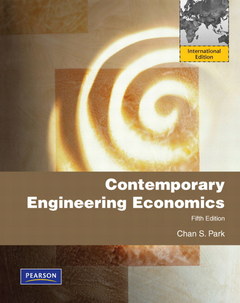Description
Contemporary engineering economics (5th ed )
Author: PARK Chan S.
Language: English
Approximative price 100.44 €
In Print (Delivery period: 12 days).
Add to cart936 p. · 19.1x23.5 cm · Paperback
Description
/li>Contents
/li>
Contemporary Engineering Economics, 5/e, is intended for undergraduate engineering students taking introductory engineering economics while appealing to the full range of engineering disciplines for which this course is often required: industrial, civil, mechanical, electrical, computer, aerospace, chemical, and manufacturing engineering, as well as engineering technology.
This edition has been thoroughly revised and updated while continuing to adopt a contemporary approach to the subject, and teaching, of engineering economics. This text aims not only to build a sound and comprehensive coverage of engineering economics, but also to address key educational challenges, such as student difficulty in developing the analytical skills required to make informed financial decisions.
PART 1 BASICS OF FINANCIAL DECISIONS 1
Chapter 1 Engineering Economic Decisions
1.1 Role of Engineers in Business
1.1.1 Types of Business Organization
1.1.2 Engineering Economic Decisions
1.1.3 Personal Economic Decisions
1.2 What Makes the Engineering Economic Decision Difficult?
1.3 Economic Decisions Versus Design Decisions
1.4 Large-Scale Engineering Projects
1.4.1 How a Typical Project Idea Evolves
1.4.2 Impact of Engineering Projects on Financial Statements
1.4.3 A Look Back in 2009: Did Toyota Make the Right Decision?
1.5 Common Types of Strategic Engineering Economic Decisions
1.6 Fundamental Principles of Engineering Economics
Summary
Short Case Studies
Chapter 2 Accounting and Financial Decision-Making
2.1 Accounting: The Basis of Decision Making
2.2 Financial Status for Businesses
2.2.1 The Balance Sheet
2.2.2 The Income Statement
2.2.3 The Cash Flow Statement
2.3 Using Ratios to Make Business Decisions
2.3.1 Debt Management Analysis
2.3.2 Liquidity Analysis
2.3.3 Asset Management Analysis
2.3.4 Profitability Analysis
2.3.5 Market Value Analysis
2.3.6 Limitations of Financial Ratios in Business Decisions
Summary
Problems
Short Case Studies
Chapter 3 Interest Rate and Economic Equivalence
3.1 Interest: The Cost of Money
3.1.1 The Time Value of Money
3.1.2 Elements of Transactions Involving Interest
3.1.3 Methods of Calculating Interest
3.1.4 Simple Interest versus Compound Interest
3.2 Economic Equivalence
3.2.1 Definition and Simple Calculations
3.2.2 Equivalence Calculations: General Principles
3.3 Development of Formulas for Equivalence Calculations
3.3.1 The Five Types of Cash Flows
3.3.2 Single-Cash-Flow Formulas
3.3.3 Uneven Payment Series
3.3.4 Equal-Payment Series
3.3.5 Linear-Gradient Series
3.3.6 Geometric Gradient Series
3.4 Unconventional Equivalence Calculations
3.4.1 Composite Cash Flows
3.4.2 Determining an Interest Rate to Establish Economic Equivalence
3.4.3 Unconventional Regularity in Cash Flow Pattern
Summary
Problems
Short Case Studies
Chapter 4 Understanding Money and Its Management
4.1 Nominal and Effective Interest Rates
4.1.1 Nominal Interest Rates
4.1.2 Effective Annual Interest Rates
4.1.3 Effective Interest Rates per Payment Period
4.1.4 Continuous Compounding
4.2 Equivalence Calculations with Effective Interest Rates
4.2.1 When Payment Period is Equal to Compounding Period
4.2.2 Compounding Occurs at a Different Rate than That at Which Payments are Made
4.2.4 Compounding is Less Frequent than Payments
4.3 Equivalence Calculations with Continuous Payments
4.3.1 Single-Payment Transactions
4.3.2 Continuous-Funds Flow
4.4 Changing Interest Rates
4.4.1 Single Sums of Money
4.4.2 Series of Cash Flows
4.5 Debt Management
4.5.1 Commercial Loans
4.5.2 Loan versus Lease Financing
4.5.3 Home Mortgage
4.6 Investing in Financial Assets
4.6.1 Investment Basics
4.6.2 How to Determine Your Expected Return
4.6.3 Investing in Bonds
Summary
Problems
Short Case Studies
PART 2 EVALUATION OF BUSINESS AND ENGINEERING ASSETS 207
Chapter 5 Present-Wo
These books may interest you

Science for Engineering, 5th ed 209.19 €



